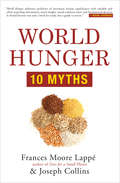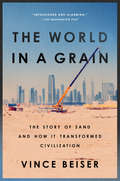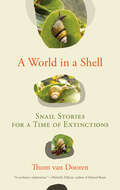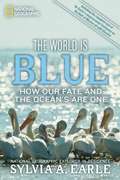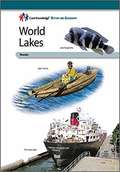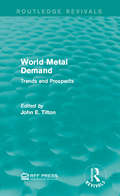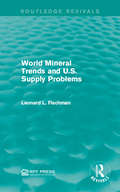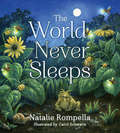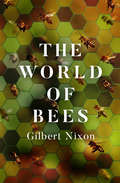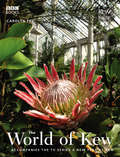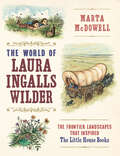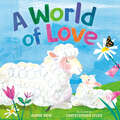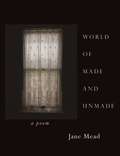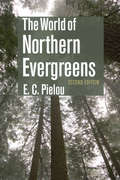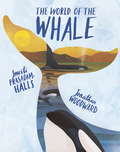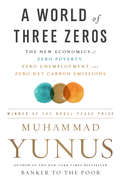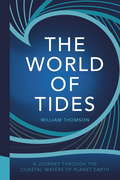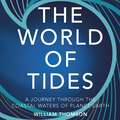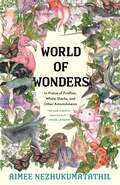- Table View
- List View
World Hunger: 10 Myths
by Joseph Collins Frances Moore LappéFrom bestselling authors Frances Moore Lappé and Joseph Collins comes the 21st century’s definitive book on world hunger. Driven by the question, "Why hunger despite an abundance of food?" Lappé and Collins refute the myths that prevent us from addressing the root causes of hunger across the globe. World Hunger: Ten Myths draws on extensive new research to offer fresh, often startling, insights about tough questions-from climate change and population growth to genetically modified organisms (GMOs) and the role of U.S. foreign aid, and more.Brimming with little-known but life-changing examples of solutions to hunger worldwide, this myth-busting book argues that sustainable agriculture can feed the world, that we can end nutritional deprivation affecting one-quarter of the world’s people, and that most in the Global North have more in common with hungry people than they thought. For novices and scholars alike, World Hunger: Ten Myths will inspire a whole new generation of hunger-fighters.
The World in a Grain: The Story of Sand and How It Transformed Civilization
by Vince BeiserThe gripping story of the most important overlooked commodity in the world--sand--and the crucial role it plays in our lives.After water and air, sand is the natural resource that we consume more than any other--even more than oil. Every concrete building and paved road on Earth, every computer screen and silicon chip, is made from sand. From Egypt's pyramids to the Hubble telescope, from the world's tallest skyscraper to the sidewalk below it, from Chartres' stained-glass windows to your iPhone, sand shelters us, empowers us, engages us, and inspires us. It's the ingredient that makes possible our cities, our science, our lives--and our future.And, incredibly, we're running out of it.The World in a Grain is the compelling true story of the hugely important and diminishing natural resource that grows more essential every day, and of the people who mine it, sell it, build with it--and sometimes, even kill for it. It's also a provocative examination of the serious human and environmental costs incurred by our dependence on sand, which has received little public attention. Not all sand is created equal: Some of the easiest sand to get to is the least useful. Award-winning journalist Vince Beiser delves deep into this world, taking readers on a journey across the globe, from the United States to remote corners of India, China, and Dubai to explain why sand is so crucial to modern life. Along the way, readers encounter world-changing innovators, island-building entrepreneurs, desert fighters, and murderous sand pirates. The result is an entertaining and eye-opening work, one that is both unexpected and involving, rippling with fascinating detail and filled with surprising characters.
A World in a Shell: Snail Stories for a Time of Extinctions
by Thom van DoorenFollowing the trails of Hawai&‘i&’s snails to explore the simultaneously biological and cultural significance of extinction.In this time of extinctions, the humble snail rarely gets a mention. And yet snails are disappearing faster than any other species. In A World in a Shell, Thom van Dooren offers a collection of snail stories from Hawai&‘i—once home to more than 750 species of land snails, almost two-thirds of which are now gone. Following snail trails through forests, laboratories, museums, and even a military training facility, and meeting with scientists and Native Hawaiians, van Dooren explores ongoing processes of ecological and cultural loss as they are woven through with possibilities for hope, care, mourning, and resilience. Van Dooren recounts the fascinating history of snail decline in the Hawaiian Islands: from deforestation for agriculture, timber, and more, through the nineteenth century shell collecting mania of missionary settlers, and on to the contemporary impacts of introduced predators. Along the way he asks how both snail loss and conservation efforts have been tangled up with larger processes of colonization, militarization, and globalization. These snail stories provide a potent window into ongoing global process of environmental and cultural change, including the largely unnoticed disappearance of countless snails, insects, and other less charismatic species. Ultimately, van Dooren seeks to cultivate a sense of wonder and appreciation for our damaged planet, revealing the world of possibilities and relationships that lies coiled within a snail&’s shell.
The World Is Blue: How Our Fate and the Ocean's Are One
by Sylvia A. EarleExplorer-in-residence at the National Geographic Society, oceanographer Earle adds blue to the green movement by explaining the importance of the earth's ocean to the health of its life. She begins by setting out the conventional vision of the ocean's limitless bounty for harvesting wildlife and infinite resiliency as the ultimate garbage disposal. Then she explains how the ocean is suffering from biodiversity loss, drilling, mining, shipping, spilling, and changing climate and chemistry. The final section surveys opportunities for reversing the tide by exploring and governing the ocean, smart aquaculture, and protective measures. Annotation c2009 Book News, Inc., Portland, OR (booknews.com)
The World Is Ours to Cherish: A Letter to a Child
by Mary Annaïse HeglarThis hopeful picture book--written in the style of a letter--gives kids an honest take on climate change and urges them to band together to help the planet.The world is a big, beautiful place full of natural wonders--everything from bees to rainfall can seem magical.The world is also changing. Climate change has already had a devastating effect on the planet.But it's not too late! If we work together and show a little more care, both for the environment and each other, we can keep this world beautiful.This moving debut from climate writer Mary Annaïse Heglar is perfect for budding environmentalists and anyone in need of a little hope for the future of our planet.
World Lakes (Core Knowledge History and Geography)
by Core Knowledge FoundationWORLD LAKES begins with a review of map skills and geographical terms. Students learn about the benefits and resources provided by lakes, including, in Asia, the Caspian and Aral Seas; in Africa, Lakes Victoria, Tanganyika, and Chad; in South America, Lakes Maracaibo and Titicaca; and, in North America, Lakes Superior, Huron, Michigan, Erie, and Ontario.
World Metal Demand: Trends and Prospects (Routledge Revivals)
by John E. TiltonIn the early 1970s, the post-World War II boom in world metal consumption came to a halt. As time passed, it became clear that what many first thought to be a cyclical downturn was instead a long-term, substantial decline in world metal demand. In this volume, first published in 1990, editor John E. Tilton and four fellow scholars of mineral economics analyse the causes and consequences of this decline and the prospects for future growth in world metal demand. This book will be of interest to students of business and environmental studies.
World Mineral Trends and U.S. Supply Problems (Routledge Revivals)
by Leonard L. FischmanEven though the United States relies heavily on imports for many non-fuel minerals, mineral supply has played only a small role in foreign policy since World War II. Originally published in 1980, this report investigates seven major non-fuel minerals in relation to long-term potential supply and price problems and any short-term issues that may arise to put concerns about supply in perspective for policy-makers. This title will be of interest to students of Environmental Studies and professionals.
The World Never Sleeps (Tilbury House Nature Book #0)
by Natalie Rompella Carol SchwartzMidnight. Stars speckle the darkness with bits of light. A cockroach skitters across the kitchen floor to snatch a forgotten breadcrumb. In the backyard, a spider weaves an intricate design on the fence. Winged insects dance and flicker in the porch light. Day and night, small creatures are busy working, eating, hunting, hiding. This nonfiction picture book reveals the hidden lives of insects and other small creatures from one midnight to the next. The world may appear to be sleeping in the dead of night, but it is not. As moonflowers open and stars shine, nature goes about her business. The world never sleeps. Natalie Rompella’s lyrical text is vividly complemented by Carol Schwartz’s watercolors. A cat roams through the illustrations—silent witness, in the house and in the yard, to the myriad lives of night and day. A sense of mystery pervades all—even the backmatter natural-history portraits of the animals met in the book. This nature book invites children into a parallel universe, one that teems with life while they sleep. Lexile Level 700; F&P Level O
The World of Bees
by Gilbert NixonAn entomologist presents a beautifully illustrated study of bees, from their behavior to social structures, colonies, and relationship to the environment. In this engaging and scholarly volume, entomologist Gilbert Nixon shares his lifelong fascination with bees. Nixon&’s childhood love of these curious insects led to decades of study as he learned to identify their distinctive markings and pursued the secrets of their mystifying behaviors.The World of Bees offers a comprehensive introduction to various species of bees, including honey bees, bumblebees, and leafcutter bees, as well as information on related insects such as botflies and wasps. With color illustrations by Arthur Smith, this expert volume covers all major topics in melittology, including mating habits, life cycles, pollination, bee dances, and more.
The World of Kew
by Carolyn FryWithout plants, there would be no life on earth. Kew Gardens is famous for its breathtaking displays of flowers and tree,s but this World Heritage Site is also a globally important scientific and historical organization. Scientists and gardeners use the plants and knowledge that have been collected at Kew since the eighteenth century to advance understanding of the earth's environment and of how plant lfe can be used for human benefit. Published to accompany the ten-part BBC2 series A New Year at Kew, this fascinating book takes us behind the scenes to show the extraordinary range of work carried out at Kew Gardens and Wakehurst Place - home to the Millenium Seed Bank - and by Kew staff overseas. From using forensic botant to micropagating plants facing extinction, from investigating herbal cures from Alzheimer's disease to replanting the volcano-ravaged island of Montserrat, the book shows us aspects of Kew's work that are largely hidden from view abut the benefits of which are far reachingl In the process it provides an absorbing and accessible introduction to such topical subjects as biodiversity, practical conservation and economic botany. Lavishly illustrated and filled with engrossing stories and engaging characters, this book brings to life the world of Kew and the global importance of its work.
The World of Laura Ingalls Wilder: The Frontier Landscapes that Inspired the Little House Books
by Marta McDowell“For gardeners, botanists, and fans of Laura Ingalls Wilder, this book looks at the beloved Little House on the Prairie author’s relationship to nature.” —Publishers Weekly The universal appeal of Laura Ingalls Wilder’s books springs from a life lived in partnership with the land, on farms she and her family settled across the Northeast and Midwest. In this revealing exploration of Wilder’s deep connection with the natural world, Marta McDowell follows the wagon trail of the beloved Little House series. You’ll learn details about Wilder’s life and inspirations, pinpoint the Ingalls and Wilder homestead claims on authentic archival maps, and learn to grow the plants and vegetables featured in the series. Excerpts from Wilder’s books, letters, and diaries bring to light her profound appreciation for the landscapes at the heart of her world. Featuring the beloved illustrations by Helen Sewell and Garth Williams, plus hundreds of historic and contemporary photographs, The World of Laura Ingalls Wilder is a treasure for anyone enchanted by Laura’s wild and beautiful life.
A World of Love
by Aimee Elizabeth ReidThere are a world of ways to show love for our young!Animal parents shower their little ones with love in so many unique ways. Doves coo and dolphins whistle, while penguins huddle with their chicks for warmth and mountain goats shield their kids&’ falls. Eye-catching collage illustrations and a lyrical text invite readers to explore animal behavior around the globe and celebrate the universal nature of a caregiver&’s love.
World of Made and Unmade
by Jane MeadMead's fifth collection candidly and openly explores the long process that is death. These resonant poems discover what it means to live, die, and come home again. We're drawn in by sorrow and grief, but also the joys of celebrating a long life and how simple it is to find laughter and light in the quietest and darkest of moments.
The World of Northern Evergreens
by E. C. PielouPraise for the first edition—"This book is guaranteed to enrich the reader's next forest visit."—Library Journal"Pielou's book brings forest ecology to naturalists, bird lovers, hikers, cyclists, canoeists, skiers, mountaineers, and back-country campers."—Seattle Post-Intelligencer"It is E. C. Pielou's contention that evergreen forests... are taken for granted and rarely well understood. To remedy this, the distinguished biogeographer has written a book focusing on the northern evergreen forests. This is a book that many naturalists, both novice and experienced, will read with pleasure and interest."—Canadian Field-Naturalist "Pielou makes a strong, irrefutable, case for the preservation of old-growth forests and wilderness. Anyone who appreciates the outdoors should have this book and take its message to heart."—Forest Planning Canada Global warming and human-driven impacts from logging, natural gas drilling, mining of oil sands, and the development of hydropower increasingly threaten North America's northern forests. These forests are far from being a uniform environment; close inspection reveals that the conifers that thrive there—pines, larches, spruces, hemlocks, firs, Douglas-firs, arborvitaes, false-cypresses, junipers, and yews—support a varied and complex ecosystem. In The World of Northern Evergreens, the noted ecologist E. C. Pielou introduces the biology of the northern forests and provides a unique invitation to naturalists, ecologists, foresters, and everyone living in northern North America who wants to learn about this unique and threatened northern world and the species that make it their home. Through identification keys, descriptions, and life histories of the conifer tree species, the author emphasizes how different these plants are both biologically and evolutionarily from the hardwoods we also call "trees." Following this introduction to the essential conifers, the author's perceptive insights expand to include the interactions of conifers with other plants, fungi, mammals, birds, and amphibians. The second edition, enriched by new illustrations by the author of woodland features and creatures, updates the text to include new topics including mycorrhizal fungi, soil, woodlice, bats, and invasive insects such as the hemlock woolly adelgid. Emphasis is given to the very real human-driven impacts that threaten the species that live in and depend on the vital and complex forest ecosystem. Pielou provides us with a rich understanding of the northern forests in this work praised for its nontechnical presentation, scientific objectivity, and original illustrations.
The World of the Beaver
by Leonard Lee Rue III"According to a Cherokee legend," writes Leonard Lee Rue in The World of the Beaver, "it was the Great Spirit, with the help of gigantic beavers, who created the earth. The earth had been covered with water until the Great Spirit sent the beavers diving down beneath the surface to dredge up mud from the bottom to form land masses." Although the beaver is not, nowadays, as big as his legendary ancestors, he continues to be enormously helpful to man and beast. Here Leonard Lee Rue reveals the world and way of life of the good -natured, industrious American beaver and follows him through a full year of his ordinary activities. How does a beaver fell a tree? What does he eat? Is he polygamous or monogamous? How does he build a dam? What does the inside of his lodge look like? Who has been his most deadly enemy in America? The author-whose interest in beavers has caused him to go swimming with them and, on one occasion, led to his becoming stuck in the passage to a lodge-answers all these questions and many others. The informal narrative and the author's remarkable photographs make this really first-rate reading for the nature student and for the ordinary reader. "As intent as man seems to be on destroying the earth," writes Leonard Lee Rue in conclusion, "the Creator may again have to call upon the beavers to help patch things up. The earth's future couldn't be in better paws."
The World of the Bobcat (A Living World Book)
by Joe Van WormerCan anybody really "lick his weight in wildcats?" Never, says Joe Van Wormer in this magnificent photo-and- text study of Lynx rufus, better known as the bobcat, or wildcat. In fact, he says, it is extremely doubtful that a 200-pound man could handle the average bobcat, which weighs less than 20 pounds. The bobcat is an elusive and secretive creature, and although he often lives close to civilization, it is impossible to make any prolonged observation of him in the wild. Joe Van Wormer, however, has observed bobcats' dens and followed their trails. He has talked to many people who hunt or own them. He has known a number of domesticated bobcats and has encountered many wild ones, often with the treed cat crouching on one limb and himself, with camera, on another only six or eight feet away. What is the family unit of the bobcat? Where does he live and what does he eat? How does he feel about humans? About his cousin, the house cat? Who are his natural enemies? The informal text and breath-taking photographs are a revelation of the temperament, habits, and lives of these strikingly beautiful nocturnal creatures - whose yellowish eyes, it was once believed, could see through wood and stone.
The World of the Gull (A Living World Book)
by David F. CostelloThe world of the gull extends from the barren Arctic wastes to the burning sands of Arabia, from the storm clouds of Tierra del Fuego to the farmlands of our own Great Plains. Equipped with extraordinary flying ability, intelligence, and an enviable digestion, gulls lead strange and wonderful lives. Born opportunists, they are completely adaptable, self-sufficient creatures, equally at home on land or sea-one of the few members of the animal kingdom able to drink both fresh and salt water. Unlike most other birds, gulls walk, fly, and swim with ease. These capabilities put them in touch with an unlimited variety of food-from cherries, mice, brine fly larvae, wheat, and steak bones to eggs, worms, and young ducks-and make them one of nature's most valuable scavengers. David Costello describes all aspects of the gulls' life cycle-their ritualistic courtship and nesting habits, the rearing of their young, colony formation, food finding, natural enemies, and their remarkable migrations over the face of the earth.
The World of the Otter (Living World Book)
by Ed ParkEver wondered how those otters on the river bank are so playful, what do they eat, where do they live, how do they survive the winter? In this book by naturalist Ed Park, who has studied otters for years, you will find the answers to these questions and get to know the clowns of the river bank more closely.
The World of the Whale
by Smriti Prasadam-HallsDive into the underwater world of whales and dolphins in this entrancing illustrated guide. Graceful and serene, intelligent and social, the whale is a wonder of the deep blue sea. And yet, whales rely on air to breathe - they are mammals, just like us.With breathtaking text, Smriti Prasadam-Halls explores the migrations, songs and family life of these mysterious creatures, and reveals the dangers they face from plastic, pollution and hunting. Wildlife illustrator Jonathan Woodward brings the marine world to life with stunning papercut collage artwork. An astonishing follow-up to the English 4-11 Award-winning book The Ways of the Wolf, which is also shortlisted for the SLA Award.'The expressive writing and the colourful, original artwork depict the lives of whales perfectly. Perceptively illustrating their strong social nature and intelligence, this beautiful book also explores the dangers faced by these incredible creatures and the need for us to work together to protect them.' - Whale & Dolphin Conservation
A World of Three Zeros: The New Economics Of Zero Poverty, Zero Unemployment, And Zero Carbon Emissions
by Muhammad YunusA winner of the Nobel Peace Prize and bestselling author of Banker to the Poor offers his vision of an emerging new economic system that can save humankind and the planet Muhammad Yunus, who created microcredit, invented social business, and earned a Nobel Peace Prize for his work in alleviating poverty, is one of today's most trenchant social critics. Now he declares it's time to admit that the capitalist engine is broken--that in its current form it inevitably leads to rampant inequality, massive unemployment, and environmental destruction. We need a new economic system that unleashes altruism as a creative force just as powerful as self-interest. Is this a pipe dream? Not at all. In the last decade, thousands of people and organizations have already embraced Yunus's vision of a new form of capitalism, launching innovative social businesses designed to serve human needs rather than accumulate wealth. They are bringing solar energy to millions of homes in Bangladesh; turning thousands of unemployed young people into entrepreneurs through equity investments; financing female-owned businesses in cities across the United States; bringing mobility, shelter, and other services to the rural poor in France; and creating a global support network to help young entrepreneurs launch their start-ups. In A World of Three Zeros, Yunus describes the new civilization emerging from the economic experiments his work has helped to inspire. He explains how global companies like McCain, Renault, Essilor, and Danone got involved with this new economic model through their own social action groups, describes the ingenious new financial tools now funding social businesses, and sketches the legal and regulatory changes needed to jumpstart the next wave of socially driven innovations. And he invites young people, business and political leaders, and ordinary citizens to join the movement and help create the better world we all dream of.
The World of Tides: A Journey Through the Coastal Waters of Planet Earth
by William ThomsonIn The Book of Tides, William Thomson took the reader on a mesmerising journey round the coast of Britain. Now, he sets out with his surfboard and tidal compass to encounter the waters of the world, charting his most extraordinary sights and experiences. These include the whirlpools of the Arctic circle, the world's biggest ever surfed wave off Portugal, the strongest whirlpool in Norway and, in Australia, the most dangerous rapids known to us.With the enticing combination of William's passionate text and collectable mapping illustrations, this is a book for anyone who feels the pull of the tides and call of the sea.FEATURING:New ZealandAustraliaPortugalFranceEnglandScotlandNorwayThe NetherlandsSpainIndonesiaChinaJapanUSACanadaBelize
The World of Tides: A Journey Through the Coastal Waters of Planet Earth
by William ThomsonIn The Book of Tides, William Thomson took the reader on a mesmerising journey round the coast of Britain. Now, he sets out with his surfboard and tidal compass to encounter the waters of the world, charting his most extraordinary sights and experiences. These include the whirlpools of the Arctic circle, the world's biggest ever surfed wave off Portugal, the strongest whirlpool in Norway and, in Australia, the most dangerous rapids known to us.With the enticing combination of William's passionate text and collectible mapping illustrations, this is a book for anyone who feels the pull of the tides and call of the sea.FEATURING:New ZealandAustraliaPortugalFranceEnglandScotlandNorwayThe NetherlandsSpainIndonesiaChinaJapanUSACanadaBelize(P)2017 Quercus Editions Limited
World of Wonders: In Praise of Fireflies, Whale Sharks, and other Astonishments
by Aimee NezhukumatathilFrom beloved, award-winning poet Aimee Nezhukumatathil comes a debut work of nonfiction-a collection of essays about the natural world, and the way its inhabitants can teach, support, and inspire us.
